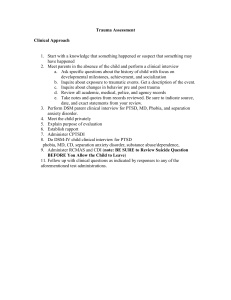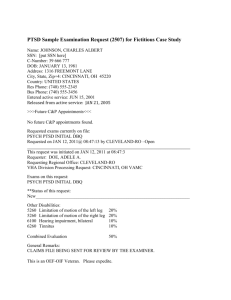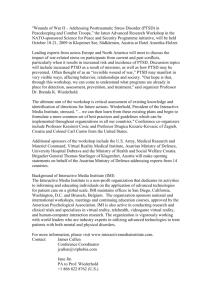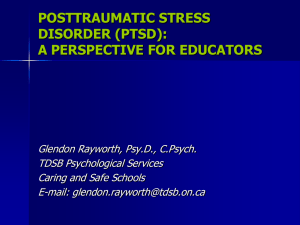Proposed Changes To PTSD Diagnosis in DSM
advertisement
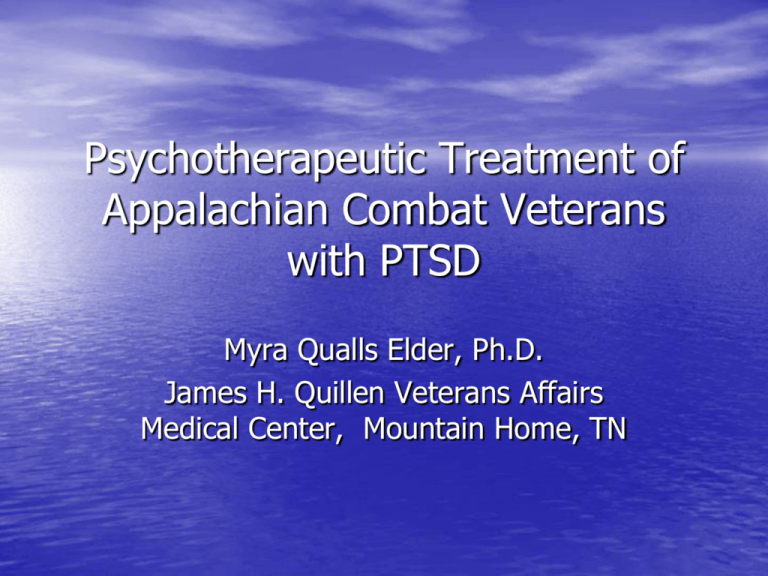
Psychotherapeutic Treatment of Appalachian Combat Veterans with PTSD Myra Qualls Elder, Ph.D. James H. Quillen Veterans Affairs Medical Center, Mountain Home, TN Post Traumatic Stress Disorder • Trauma: Outside normal range of human experience • Re-experiencing the trauma: – Nightmares – Intrusive memories – Flashbacks – Distress when faced with triggers PTSD Symptoms: Avoidance • Avoidance of thoughts, feelings, people, places assoc. w/ the trauma • Detachment/numbing/estrangement • Some amnesia of trauma • Foreshortened future • Loss of interest in activities PTSD Symptoms: Arousal • Insomnia/broken sleep • Irritability/anger • Problems concentrating • Hypervigilance • Exaggerated startle response Symptoms listed in DSM-IV-TR Proposed Changes To PTSD Diagnosis in DSM-V (2013) • Event experienced by close relative/friend • Do not need to feel fear/helplessness/horror • Repeated exposure to distressing details of events of others (police officer, for ex.) • Criterion D: negative thoughts, moods, or evaluations of self and/or world • (Thanks to Dr. Tom Stoss for this information) Appalachian Veteran-Specific Diagnostic Questions • When do you do your grocery shopping? • Do you ever eat at a restaurant? Where do you sit? • Is there a gun in your bedroom? How many guns are in your house? • How many times a night do you check your window/door locks? • What do you do on July 4th? PTSD Prevalence Data • Community stats: current PTSD rates = 5-6% • • men, 10-12% women National Vietnam Veterans Readjustment Study (mid-1980s): then-current PTSD rates = 15% men, 8% women Lifetime rates: 30% men, 25% women (cited in Friedman, 2004) PTSD Prevalence Data II • Operation OIF/OEF: 2008 Rand Institute Study: 18.5% diagnosed with PTSD • 35% of Iraq war vets accessed MH svcs in the year after returning home (Hoge, et al., 2006) • 2001-2005, N = 103,788 OEF/OIF vets: 25% received MH dxs, 56% of those rec’d 2 MH dxs, skewed toward vets 18-24 (Seal, et al., 2007) National Center for PTSD Data • 12% to 20% soldiers and Marines had PTSD after serving in Iraq • 7% to 15% had depression after serving in Iraq or Afghanistan • 1 in every 4 soldiers or Marines reported using alcohol more than they meant to • 1 of every 3 returning soldiers treated by the VA for MH issues Now what? • Establish trust: necessary condition • Must be present: minimize distraction, pay attention, have two channels open • Must be engaged: reflective is good, responsive is better, avoid being reactive • Patient must feel as safe as possible, physically and emotionally (ex. windows, pagers, intrusions) Conditions Necessary for Tx • Time: no substitute for this, need it for trust to develop • Maslow’s Triad: can it be taught? • Culture/Context: military training, masculinity, Appalachian (“Alvin York Syndrome”) • Military service an honorable way to individuate from an enmeshed family From Sebastian Junger’s 2010 book, “War,” about the 173rd in Afghanistan • “War is supposed to feel bad because undeniably bad things happen in it, but for a 19-y.o. at the working end of a .50 cal during a firefight that everyone comes out of okay, war is life multiplied by some number that no one has ever heard of. In some ways, 20min of combat is more life than you could scrape together in a lifetime of doing something else.” Early Therapeutic Tasks • Orientation to therapy • Rationale for therapy: “crude oil to gasoline” and reducing avoidance • Possible negative and positive effects of therapy (this is informed consent) • Educate about PTSD & talk to spouse. • Analogy of physical therapy: “frozen shoulder” The “A” Problems in PTSD • Anger • Alcohol • Avoidance Early and Mid-Tx Tasks • Therapeutic deed, not just word • Assessing and creating coping skills FIRST: distraction, relaxation, music, hobbies, social support, exercise • Then, constructing the trauma narrative • Hearing the hard stuff and staying present • Dealing with current life stressors/issues Middle and Later Therapy Tasks • Decreasing affective reactivity: must learn words for emotions (visual to verbal) • Decreasing maladaptive behaviors • Decreasing “stinking thinking:” with vets, all-or-nothing thinking and paranoia very common • Increasing some integration into society • Increasing self-efficacy: homework PTSD is a chronic condition • Balance instillation of hope with realistic view: there will be exacerbations • Current stress, medical problems, travel away from home, media exposure to ongoing war, substance use/abuse • Anniversary reactions • The body remembers Potential Pitfalls • Secondary traumatization • Patient dropping out in middle of trauma narrative • Unrealistic expectations • Acting out (patient, not therapist) • Exhaustion (therapist and patient) Psychologist Self-Care • Balance case-load • Peer supervision and/or occasional therapy to “offload baggage” • Stable and balanced life away from work • Seeing work as meaningful Does Therapy Work? • 40 years of data on therapy: patient’s rating of the alliance is the best predictor of engagement and outcome • All therapy models show that the most change occurs early in the therapeutic process • Therapy accounts for 13% of variance for change (Wampold, 2001, cited by Miller, 2007) PTSD Therapy Outcome Data • Limited data, focuses on: • Exposure-based therapies • Cognitive Behavioral Therapy • EMDR • Small-scale studies, different populations (rape and accident victims, vets), modest treatment gains/effect sizes Difficult to Measure Prevented Behaviors • Who did not commit suicide? • Who did not commit homicide? • Who did not drink/use drugs? • Who did not abuse family members? • “Maybe the ultimate wound is the one that makes you miss the war you got it in.” - Sebastian Junger, “War”

